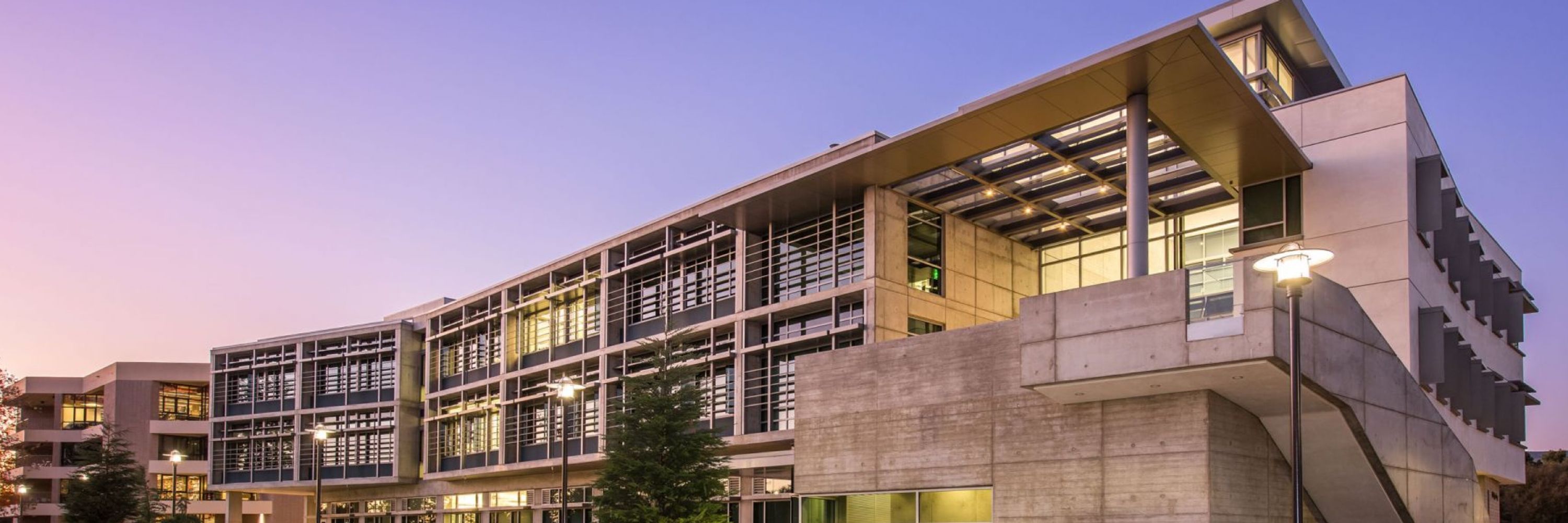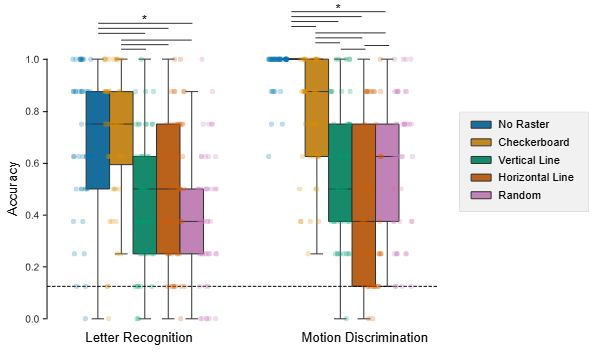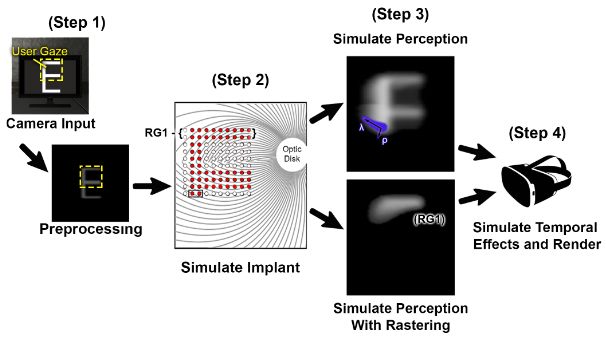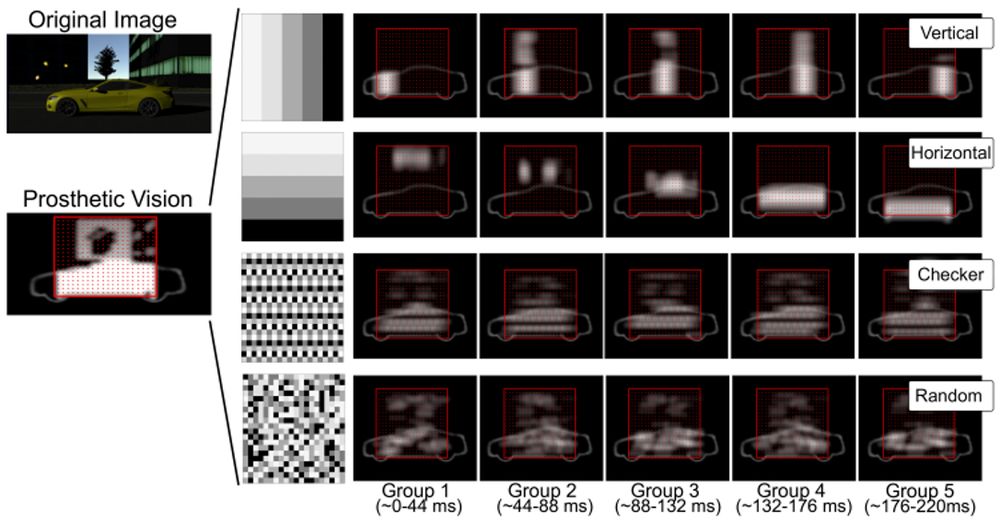
Bionic Vision Lab
@bionicvisionlab.org
👁️🧠🖥️🧪🤖 What would the world look like with a bionic eye? Interdisciplinary research group at UC Santa Barbara. PI: @mbeyeler.bsky.social
#BionicVision #Blindness #NeuroTech #VisionScience #CompNeuro #NeuroAI
#BionicVision #Blindness #NeuroTech #VisionScience #CompNeuro #NeuroAI
✅ Checkerboard consistently outperformed the other patterns—higher accuracy, lower difficulty, fewer motion artifacts.
💡 Why? More spatial separation between activations = less perceptual interference.
It even matched performance of the ideal “no raster” condition, without breaking safety rules.
💡 Why? More spatial separation between activations = less perceptual interference.
It even matched performance of the ideal “no raster” condition, without breaking safety rules.

July 9, 2025 at 4:55 PM
✅ Checkerboard consistently outperformed the other patterns—higher accuracy, lower difficulty, fewer motion artifacts.
💡 Why? More spatial separation between activations = less perceptual interference.
It even matched performance of the ideal “no raster” condition, without breaking safety rules.
💡 Why? More spatial separation between activations = less perceptual interference.
It even matched performance of the ideal “no raster” condition, without breaking safety rules.
We ran a simulated prosthetic vision study in immersive VR using gaze-contingent, psychophysically grounded models of epiretinal implants.
🧪 Powered by BionicVisionXR.
📐 Modeled 100-electrode Argus-like array.
👀 Realistic phosphene appearance, eye/head tracking.
🧪 Powered by BionicVisionXR.
📐 Modeled 100-electrode Argus-like array.
👀 Realistic phosphene appearance, eye/head tracking.

July 9, 2025 at 4:55 PM
We ran a simulated prosthetic vision study in immersive VR using gaze-contingent, psychophysically grounded models of epiretinal implants.
🧪 Powered by BionicVisionXR.
📐 Modeled 100-electrode Argus-like array.
👀 Realistic phosphene appearance, eye/head tracking.
🧪 Powered by BionicVisionXR.
📐 Modeled 100-electrode Argus-like array.
👀 Realistic phosphene appearance, eye/head tracking.
Checkerboard rastering has been used in #BCI and #NeuroTech applications, often based on intuition.
But is it actually better, or just tradition?
No one had rigorously tested how these patterns impact perception in visual prostheses.
So we did.
But is it actually better, or just tradition?
No one had rigorously tested how these patterns impact perception in visual prostheses.
So we did.

July 9, 2025 at 4:55 PM
Checkerboard rastering has been used in #BCI and #NeuroTech applications, often based on intuition.
But is it actually better, or just tradition?
No one had rigorously tested how these patterns impact perception in visual prostheses.
So we did.
But is it actually better, or just tradition?
No one had rigorously tested how these patterns impact perception in visual prostheses.
So we did.
👁️🧠 New paper alert!
We show that checkerboard-style electrode activation improves perceptual clarity in simulated prosthetic vision—outperforming other patterns in both letter and motion tasks.
Less bias, more function, same safety.
🔗 doi.org/10.1088/1741...
#BionicVision #NeuroTech
We show that checkerboard-style electrode activation improves perceptual clarity in simulated prosthetic vision—outperforming other patterns in both letter and motion tasks.
Less bias, more function, same safety.
🔗 doi.org/10.1088/1741...
#BionicVision #NeuroTech

July 9, 2025 at 4:55 PM
👁️🧠 New paper alert!
We show that checkerboard-style electrode activation improves perceptual clarity in simulated prosthetic vision—outperforming other patterns in both letter and motion tasks.
Less bias, more function, same safety.
🔗 doi.org/10.1088/1741...
#BionicVision #NeuroTech
We show that checkerboard-style electrode activation improves perceptual clarity in simulated prosthetic vision—outperforming other patterns in both letter and motion tasks.
Less bias, more function, same safety.
🔗 doi.org/10.1088/1741...
#BionicVision #NeuroTech
Yuchen Hou presenting at EMBC '24 in Orlando, FL (@IEEEembs @IEEEorg): We introduce two models that can predict phosphene fading & persistence under varying stimulus conditions, cross-validated on behavioral data reported by 9 Argus II users.
Preprint:...
Preprint:...

November 9, 2024 at 5:25 PM
Yuchen Hou presenting at EMBC '24 in Orlando, FL (@IEEEembs @IEEEorg): We introduce two models that can predict phosphene fading & persistence under varying stimulus conditions, cross-validated on behavioral data reported by 9 Argus II users.
Preprint:...
Preprint:...
Our students Tori LeVier and Lily Turkstra had the distinct pleasure of interviewing Dr. Philip Hessburg (@DIO_EyeOnDesign), co-founder and Director Emeritus of the Detroit Institute of Ophthalmology at...

November 9, 2024 at 5:25 PM
Our students Tori LeVier and Lily Turkstra had the distinct pleasure of interviewing Dr. Philip Hessburg (@DIO_EyeOnDesign), co-founder and Director Emeritus of the Detroit Institute of Ophthalmology at...
Find out what first got Dr. Rathbun into bionic vision and how his work with Dr. Eberhart Zrenner at the University of Tübingen (@uni_tue) inspired him to start the Bionics and Vision Lab at @HenryFordHealth!

November 9, 2024 at 5:36 PM
Find out what first got Dr. Rathbun into bionic vision and how his work with Dr. Eberhart Zrenner at the University of Tübingen (@uni_tue) inspired him to start the Bionics and Vision Lab at @HenryFordHealth!
Our students Lily Turkstra and Tori LeVier recently sat down with Dr. @DanielRathbun from @HenryFordHealth to talk about recent advancements, challenges, and future prospects of #BionicEye technologies.
Full...
Full...

November 9, 2024 at 5:25 PM
Our students Lily Turkstra and Tori LeVier recently sat down with Dr. @DanielRathbun from @HenryFordHealth to talk about recent advancements, challenges, and future prospects of #BionicEye technologies.
Full...
Full...
Come by Poster M094 tonight at #MICCAI2022 to chat about retinal implants!
Our work was also highlighted by the MICCAI Daily magazine:
https://www.rsipvision.com/MICCAI2022-Monday/16/
Our work was also highlighted by the MICCAI Daily magazine:
https://www.rsipvision.com/MICCAI2022-Monday/16/

November 9, 2024 at 5:25 PM
Come by Poster M094 tonight at #MICCAI2022 to chat about retinal implants!
Our work was also highlighted by the MICCAI Daily magazine:
https://www.rsipvision.com/MICCAI2022-Monday/16/
Our work was also highlighted by the MICCAI Daily magazine:
https://www.rsipvision.com/MICCAI2022-Monday/16/
Congratulations🎉to our graduating @UCSBpsych senior Yuchen Hou for winning 2(!) PBS awards:
- PBS Exceptional Academic Performance Award
- Abdullah & Marjorie R. Nasser Memorial Scholarship Fund Award
which recognize her academic excellence and research aptitude. Well deserved!
- PBS Exceptional Academic Performance Award
- Abdullah & Marjorie R. Nasser Memorial Scholarship Fund Award
which recognize her academic excellence and research aptitude. Well deserved!

November 9, 2024 at 5:25 PM
Congratulations🎉to our graduating @UCSBpsych senior Yuchen Hou for winning 2(!) PBS awards:
- PBS Exceptional Academic Performance Award
- Abdullah & Marjorie R. Nasser Memorial Scholarship Fund Award
which recognize her academic excellence and research aptitude. Well deserved!
- PBS Exceptional Academic Performance Award
- Abdullah & Marjorie R. Nasser Memorial Scholarship Fund Award
which recognize her academic excellence and research aptitude. Well deserved!
Into #visionscience & looking to get some paid research experience during your pre-#PhD gap year?
Come work with us & study visual perception in retinal implant users: https://recruit.ap.ucsb.edu/JPF02194
#AcademicJobs @psychologyjobs @PsychChatter @VisionScience
Come work with us & study visual perception in retinal implant users: https://recruit.ap.ucsb.edu/JPF02194
#AcademicJobs @psychologyjobs @PsychChatter @VisionScience

November 9, 2024 at 5:25 PM
Into #visionscience & looking to get some paid research experience during your pre-#PhD gap year?
Come work with us & study visual perception in retinal implant users: https://recruit.ap.ucsb.edu/JPF02194
#AcademicJobs @psychologyjobs @PsychChatter @VisionScience
Come work with us & study visual perception in retinal implant users: https://recruit.ap.ucsb.edu/JPF02194
#AcademicJobs @psychologyjobs @PsychChatter @VisionScience
As a proof of concept, we show how percept shape *might be* improved for the implant settings of three existing Argus II users.
Results are expected to be highly patient-specific, mainly depending on:
- intraocular implant location
- behaviorally reported phosphene distortions
Results are expected to be highly patient-specific, mainly depending on:
- intraocular implant location
- behaviorally reported phosphene distortions

November 9, 2024 at 5:36 PM
As a proof of concept, we show how percept shape *might be* improved for the implant settings of three existing Argus II users.
Results are expected to be highly patient-specific, mainly depending on:
- intraocular implant location
- behaviorally reported phosphene distortions
Results are expected to be highly patient-specific, mainly depending on:
- intraocular implant location
- behaviorally reported phosphene distortions
Similar to van Steveninck et al. (2021), we trained a deep net to predict the optimal stimulus to produce a desired percept.
2 important changes:
- ✅psychophysically validated phosphene model
- ❌no *de*coder (which could unlearn any deficiencies of the *en*coder)
2 important changes:
- ✅psychophysically validated phosphene model
- ❌no *de*coder (which could unlearn any deficiencies of the *en*coder)

November 9, 2024 at 5:31 PM
Similar to van Steveninck et al. (2021), we trained a deep net to predict the optimal stimulus to produce a desired percept.
2 important changes:
- ✅psychophysically validated phosphene model
- ❌no *de*coder (which could unlearn any deficiencies of the *en*coder)
2 important changes:
- ✅psychophysically validated phosphene model
- ❌no *de*coder (which could unlearn any deficiencies of the *en*coder)
We found that:
- using an #HMD may⬆️performance
- increased phosphene elongation may⬇️performance
- more electrodes do not necessarily⬆️performance
Our results highlight the importance of using an
appropriate phosphene model when predicting visual outcomes for bionic vision.
- using an #HMD may⬆️performance
- increased phosphene elongation may⬇️performance
- more electrodes do not necessarily⬆️performance
Our results highlight the importance of using an
appropriate phosphene model when predicting visual outcomes for bionic vision.


November 9, 2024 at 5:36 PM
We found that:
- using an #HMD may⬆️performance
- increased phosphene elongation may⬇️performance
- more electrodes do not necessarily⬆️performance
Our results highlight the importance of using an
appropriate phosphene model when predicting visual outcomes for bionic vision.
- using an #HMD may⬆️performance
- increased phosphene elongation may⬇️performance
- more electrodes do not necessarily⬆️performance
Our results highlight the importance of using an
appropriate phosphene model when predicting visual outcomes for bionic vision.
New work by Justin Kasowski lets you "see through the eyes" of a #BionicEye user: Immersive virtual reality simulations of bionic vision (Augmented Humans '22 @aug_humans)
Preprint: https://arxiv.org/abs/2203.05675
Code:...
Preprint: https://arxiv.org/abs/2203.05675
Code:...

November 9, 2024 at 5:25 PM
New work by Justin Kasowski lets you "see through the eyes" of a #BionicEye user: Immersive virtual reality simulations of bionic vision (Augmented Humans '22 @aug_humans)
Preprint: https://arxiv.org/abs/2203.05675
Code:...
Preprint: https://arxiv.org/abs/2203.05675
Code:...
She has also reported on the importance of field of view (FoV) in visual prosthesis design (https://doi.org/10.1088/1741-2552/abb9be) and prototyped an #AugmentedReality system for navigation (https://arxiv.org/abs/2109.14957).
We can't wait to tell you what's next!
We can't wait to tell you what's next!

November 9, 2024 at 5:42 PM
She has also reported on the importance of field of view (FoV) in visual prosthesis design (https://doi.org/10.1088/1741-2552/abb9be) and prototyped an #AugmentedReality system for navigation (https://arxiv.org/abs/2109.14957).
We can't wait to tell you what's next!
We can't wait to tell you what's next!
You may have heard about her work on combining structural and semantic segmentation to improve indoor scene understanding with simulated prosthetic vision:
https://doi.org/10.1371/journal.pone.0227677
https://doi.org/10.1371/journal.pone.0227677

November 9, 2024 at 5:36 PM
You may have heard about her work on combining structural and semantic segmentation to improve indoor scene understanding with simulated prosthetic vision:
https://doi.org/10.1371/journal.pone.0227677
https://doi.org/10.1371/journal.pone.0227677
We are excited to welcome the lab's first #postdoc: Melani Sanchez Garcia, who graduated with a PhD in Computer Science and Systems Engineering (cum laude) @unizar.
She'll be working on new ways to apply #ComputerVision/#MachineLearning to the...
She'll be working on new ways to apply #ComputerVision/#MachineLearning to the...

November 9, 2024 at 5:25 PM
We are excited to welcome the lab's first #postdoc: Melani Sanchez Garcia, who graduated with a PhD in Computer Science and Systems Engineering (cum laude) @unizar.
She'll be working on new ways to apply #ComputerVision/#MachineLearning to the...
She'll be working on new ways to apply #ComputerVision/#MachineLearning to the...
Congrats to Tanya Bhatia, Honors Student in @UCSBpsych, for winning a @sacnas Student Presentation Award at...

November 9, 2024 at 5:25 PM
Congrats to Tanya Bhatia, Honors Student in @UCSBpsych, for winning a @sacnas Student Presentation Award at...
Last but not least is John Exton (@UniofNewcastle) who is working towards an optogenetic cortical visual prosthesis.
And with this, the technical session at #TEATC2021 comes to a close. What a whirlwind it's been! See you in 2 years (hopefully in person)
And with this, the technical session at #TEATC2021 comes to a close. What a whirlwind it's been! See you in 2 years (hopefully in person)

November 9, 2024 at 7:03 PM
Last but not least is John Exton (@UniofNewcastle) who is working towards an optogenetic cortical visual prosthesis.
And with this, the technical session at #TEATC2021 comes to a close. What a whirlwind it's been! See you in 2 years (hopefully in person)
And with this, the technical session at #TEATC2021 comes to a close. What a whirlwind it's been! See you in 2 years (hopefully in person)
Seung Woo Lee (@MGHMedicine) continues Dr. Fried's presentation by detailing how micro-magnetic stimulation of V1 can lead to focal activation of downstream neurons in the human visual system.
#TEATC2021
#TEATC2021


November 9, 2024 at 6:58 PM
Seung Woo Lee (@MGHMedicine) continues Dr. Fried's presentation by detailing how micro-magnetic stimulation of V1 can lead to focal activation of downstream neurons in the human visual system.
#TEATC2021
#TEATC2021
The last session of #TEATC2021 focuses on cortical alternatives to electrical stimulation. First up is Shelley Fried (@MGHMedicine) updating us on his work towards a micro-coil based cortical visual prosthesis

November 9, 2024 at 6:52 PM
The last session of #TEATC2021 focuses on cortical alternatives to electrical stimulation. First up is Shelley Fried (@MGHMedicine) updating us on his work towards a micro-coil based cortical visual prosthesis
Zixen Ye (City University of Hong Kong) summarizes his work on light-intensity-controlled stimulation of neurons by an organic photovoltaic interface.
#TEATC2021
#TEATC2021


November 9, 2024 at 6:46 PM
Zixen Ye (City University of Hong Kong) summarizes his work on light-intensity-controlled stimulation of neurons by an organic photovoltaic interface.
#TEATC2021
#TEATC2021
Fabrizio Grani (CORTIVIS, Spain) demonstrates a closed-loop approach for automatically adjusting thresholds in cortical visual prostheses, taking into account brain state
#TEATC2021
#TEATC2021


November 9, 2024 at 6:41 PM
Fabrizio Grani (CORTIVIS, Spain) demonstrates a closed-loop approach for automatically adjusting thresholds in cortical visual prostheses, taking into account brain state
#TEATC2021
#TEATC2021
Avi Caspi (Second Sight Medical Products) demonstrates the utility of gaze-contingent stimulation for visual prostheses.
#TEATC2021
#TEATC2021


November 9, 2024 at 6:36 PM
Avi Caspi (Second Sight Medical Products) demonstrates the utility of gaze-contingent stimulation for visual prostheses.
#TEATC2021
#TEATC2021

